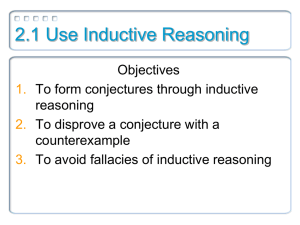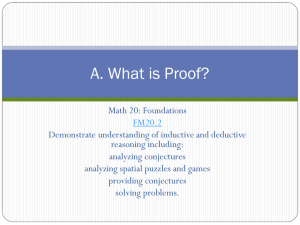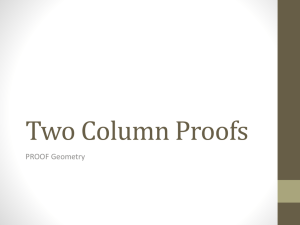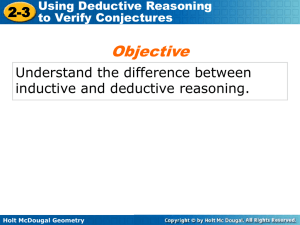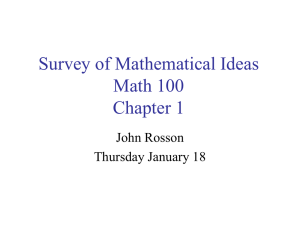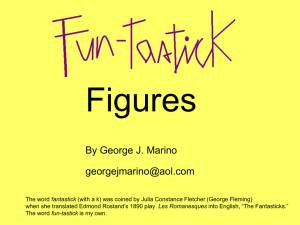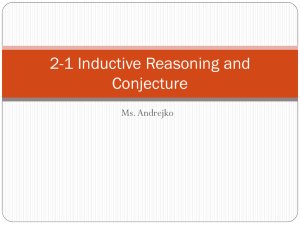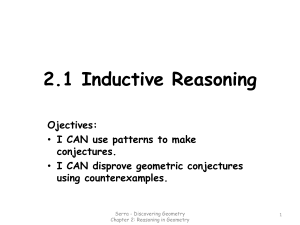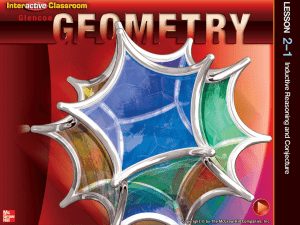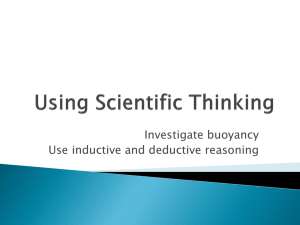Inductive reasoning
advertisement
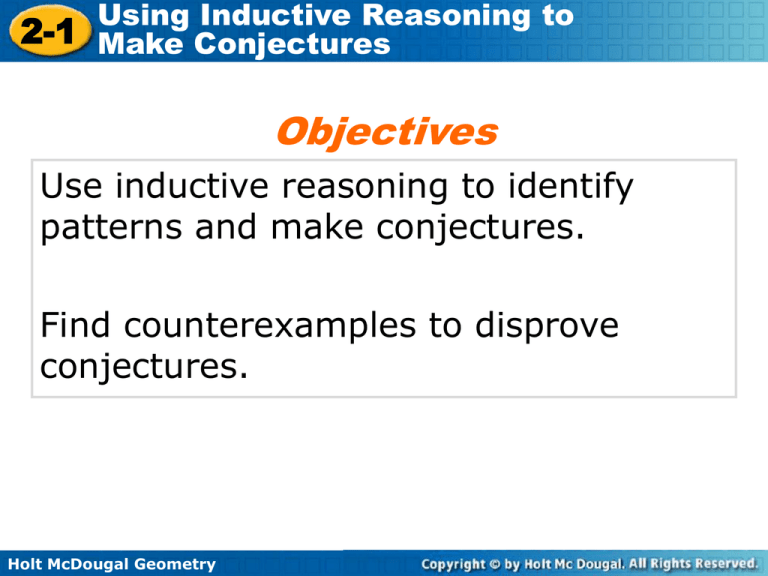
Using Inductive Reasoning to 2-1 Make Conjectures Objectives Use inductive reasoning to identify patterns and make conjectures. Find counterexamples to disprove conjectures. Holt McDougal Geometry Using Inductive Reasoning to 2-1 Make Conjectures Vocabulary inductive reasoning conjecture counterexample Holt McDougal Geometry Using Inductive Reasoning to 2-1 Make Conjectures Warm Up Find the next item in the pattern. 1. January, March, May, ... Alternating months of the year make up the pattern. The next month is July. 2. 7, 14, 21, 28, … Multiples of 7 make up the pattern. The next multiple is 35. 3. In this pattern, the figure rotates 90° counter-clockwise each time. The next figure is Holt McDougal Geometry . Using Inductive Reasoning to 2-1 Make Conjectures When several examples form a pattern and you assume the pattern will continue, you are applying inductive reasoning. Inductive reasoning is the process of reasoning that a rule or statement is true because specific cases are true. You may use inductive reasoning to draw a conclusion from a pattern. A statement you believe to be true based on inductive reasoning is called a conjecture. Holt McDougal Geometry Using Inductive Reasoning to 2-1 Make Conjectures Example 1A: Making a Conjecture Complete the conjecture. The sum of two positive numbers is ? . List some examples and look for a pattern. 1 + 1 = 2 3.14 + 0.01 = 3.15 3,900 + 1,000,017 = 1,003,917 The sum of two positive numbers is positive. Holt McDougal Geometry Using Inductive Reasoning to 2-1 Make Conjectures Example 1B: Making a Conjecture Complete the conjecture. The number of lines formed by 4 points, no three of which are collinear, is ? . Draw four points. Make sure no three points are collinear. Count the number of lines formed: AB AC AD BC BD CD The number of lines formed by four points, no three of which are collinear, is 6. Holt McDougal Geometry Using Inductive Reasoning to 2-1 Make Conjectures Check It Out! Example 1 Complete the conjecture. The product of two odd numbers is ? . List some examples and look for a pattern. 11=1 33=9 5 7 = 35 The product of two odd numbers is odd. Holt McDougal Geometry Using Inductive Reasoning to 2-1 Make Conjectures To show that a conjecture is always true, you must prove it. To show that a conjecture is false, you have to find only one example in which the conjecture is not true. This case is called a counterexample. A counterexample can be a drawing, a statement, or a number. Holt McDougal Geometry Using Inductive Reasoning to 2-1 Make Conjectures Steps of Inductive Reasoning 1. Look for a pattern. 2. Make a conjecture. 3. Prove the conjecture or find a counterexample. Holt McDougal Geometry Using Inductive Reasoning to 2-1 Make Conjectures Example 2A: Finding a Counterexample Show that the conjecture is false by finding a counterexample. For every integer n, n3 is positive. Pick integers and substitute them into the expression to see if the conjecture holds. Let n = 1. Since n3 = 1 and 1 > 0, the conjecture holds. Let n = –3. Since n3 = –27 and –27 0, the conjecture is false. n = –3 is a counterexample. Holt McDougal Geometry Using Inductive Reasoning to 2-1 Make Conjectures Example 2B: Finding a Counterexample Show that the conjecture is false by finding a counterexample. Two complementary angles are not congruent. 45° + 45° = 90° If the two congruent angles both measure 45°, the conjecture is false. Holt McDougal Geometry Using Inductive Reasoning to 2-1 Make Conjectures Check It Out! Example 2 Show that the conjecture is false by finding a counterexample. For any real number x, x2 ≥ x. 1 Let x = 2 . 1 Since 2 2 1 1 1 = 4, 4 ≥ 2 . The conjecture is false. Holt McDougal Geometry Using Inductive Reasoning to 2-1 Make Conjectures Directions Test your skills at proving conjectures TRUE or FALSE with a counterexample. With your partner - Go around the room and read the various conjectures: 1. If you think its FALSE, write an counterexample to prove it false on the paper below and put names by counterexample. 2. If you think its TRUE, write TRUE on paper below and put names by it. One point will be awarded to each unique counterexample or correct TRUE statement. One point will be deducted for each incorrect statement. Holt McDougal Geometry Using Inductive Reasoning to 2-1 Make Conjectures Determine if each conjecture is true. If false, give a counterexample. A. The quotient of two negative numbers is a positive number. true B. Every prime number is odd. false; 2 false; 90° and 90° C. Two supplementary angles are not congruent. D. The square of an odd integer is odd. true E. Three points on a plane always form a triangle F. If y-1>0, then 0<y<1 Holt McDougal Geometry

